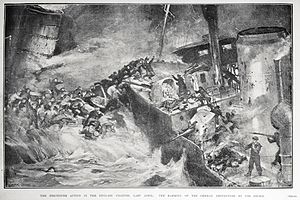Battle of Dover Strait (1917)
| Second Battle of Dover Strait | |||||||
|---|---|---|---|---|---|---|---|
| Part of the First World War | |||||||
 Drawing of HMS Broke ramming SMS G42. | |||||||
| |||||||
| Belligerents | |||||||
|
|
| ||||||
| Commanders and leaders | |||||||
|
|
| ||||||
| Strength | |||||||
|
Destroyer leader Broke Destroyer leader Swift | 6 torpedo boats | ||||||
| Casualties and losses | |||||||
|
Broke heavily damaged Swift lightly damaged 22 killed |
2 torpedo boats sunk 71 killed | ||||||
Location of battle | |||||||
The Second Battle of Dover Strait was a naval battle of the First World War, fought in the Dover Strait in April 1917 and should not be confused with the major Battle of Dover Strait in 1916. Two Royal Navy destroyers defeated a superior force of German Kaiserliche Marine torpedo boats. [1] Two German torpedo boats were sunk; the British suffered damage to both destroyers.
Background
[edit]On 20 April 1917, two groups of torpedo boats of the German Navy raided the Dover Strait to bombard Allied positions on shore and to engage warships patrolling the Dover Barrage—[2] the field of floating mines that prevented German ships from getting into the English Channel. Six torpedo boats bombarded Calais and another six bombarded Dover just before midnight.
Battle
[edit]Two flotilla leaders of the Royal Navy — HMS Broke and Swift — were on patrol near Dover and engaged six of the German ships early on 21 April near the Goodwin Sands.[3] In a confusing action, Swift torpedoed SMS G85. Broke rammed SMS G42, and the two ships became locked together. For a while, there was close-quarters fighting between the crews, as the German sailors tried to board the British ship,[1] before Broke got free and G42 sank.[4]
Aftermath
[edit]HMS Swift was slightly damaged, but Broke was heavily damaged and had to be towed back to port.[1]
Notes
[edit]Bibliography
[edit]- Baldwin, H. W. World War I: An Outline History. New York: Harper and Row, 1962.
- Chatterton, E. K. The Auxiliary Patrol. London: Sidgwick and Jackson, 1923.
- Liddle, Peter H. The Sailor's War, 1914-1918. New York: Stirling, 1985.

